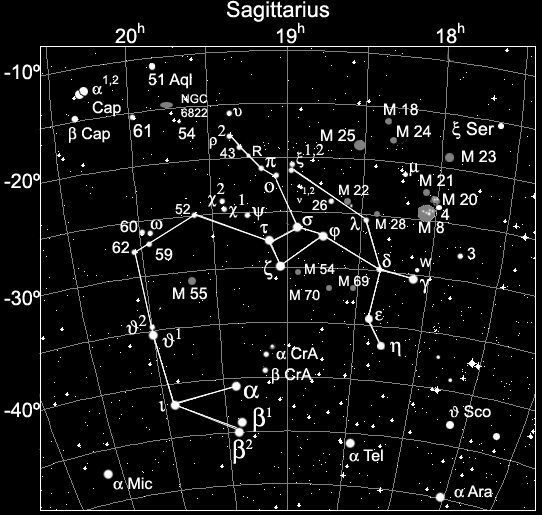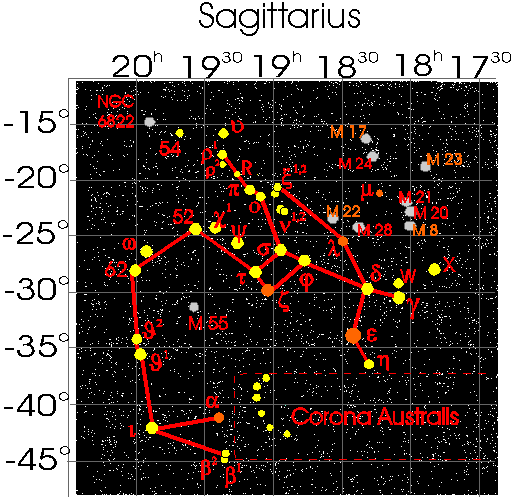
Sagittarius is a large constellation of early summer.Its collection of Messier deep sky objects is second to none; some of these are accessible to binoculars and several are even spectacular. Sagittarius is unusual in that its brightest star is neither alpha nor even beta but rather epsilon. Epsilon lies northwest of the Southern Crown while alpha and beta are in the southeast corner of this constellation. However the most noticeable asterism of Sagittarius is a distinctive trapezoid at its centre.

Alpha Sagittarii is Rukbat, the archer's knee. This faint star is found far to the south, just east of the Southern Crown and in the same FOV. Also in this field are beta1 and beta2. These unrelated stars are named ‘Arkab Prior’ and ‘Arkab Posterior’, respectively the front and the back of the leg.
Epsilon Sagittarii ‘Kaus Australis’, The Southern Part of the Bow, marks the end of the bow as held by the Archer. This 1.8 magnitude star is the brightest in the constellation, and is found between the Scorpion's stinger and the crown in Corona Australis, and about five degrees further to the north. If you are starting from the trapezoid (zeta Sgr) then move to the southwest two binocular FOVs. Now move slightly to the north; delta comes into view. This is the middle part of the archer's bow. Gamma, to the west, is the arrow head
Lambda Sagittarii is ‘Kaus Borealis’, The Northern Part of the Bow, meaning the upper tip of the bow. It's in the same field as delta, the middle part of the bow. In the same field as lambda are several of the many deep sky objects -- Messiers 22 and 28.
Mu Sagittarii is a convenient jump-off place, as it is in the centre of a region with ten Messier objects, four of which are in the same field (and two of these are wonderful binocular objects). If you place lambda at the southeastern corner of your glasses, mu is found in the northwestern corner. Now placing mu at the eastern edge brings in the four Messier deep sky objects.
Zeta Sagittarii (Ascella, the Archer's Armpit) is the southern-most star in the central trapezoid, which is the most notable asterism in this constellation. Some observers call this asterism a teapot. To locate this trapezoid draw two lines, one straight south from Altair and the other east from Antares; they meet just east of the trapezoid. It is also found due east of delta Sagittarii one binocular FOV and a bit more. All four stars which form the trapezoid are found here, confirming that you are indeed in the middle of Sagittarius. Sigma Sgr is ‘Nunki’, the Archer's hand as it aims the arrow. With the naked eye, from this trapezoid you should be able to pick out the three stars to the west that make a vertical curving line -- the Archer's bow.
